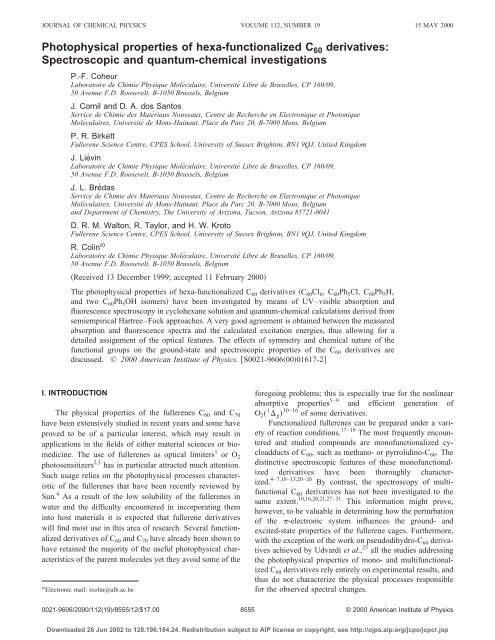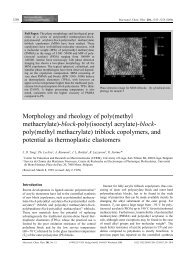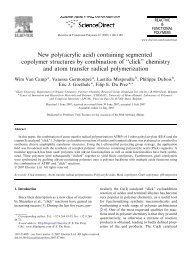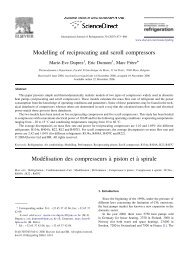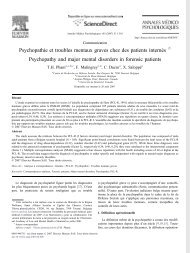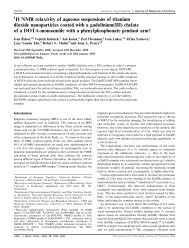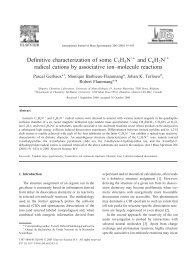Using JCP format - Université de Mons
Using JCP format - Université de Mons
Using JCP format - Université de Mons
You also want an ePaper? Increase the reach of your titles
YUMPU automatically turns print PDFs into web optimized ePapers that Google loves.
JOURNAL OF CHEMICAL PHYSICS VOLUME 112, NUMBER 19 15 MAY 2000<br />
Photophysical properties of hexa-functionalized C 60 <strong>de</strong>rivatives:<br />
Spectroscopic and quantum-chemical investigations<br />
P.-F. Coheur<br />
Laboratoire <strong>de</strong> Chimie Physique Moléculaire, Université Libre <strong>de</strong> Bruxelles, CP 160/09,<br />
50 Avenue F.D. Roosevelt, B-1050 Brussels, Belgium<br />
J. Cornil and D. A. dos Santos<br />
Service <strong>de</strong> Chimie <strong>de</strong>s Matériaux Nouveaux, Centre <strong>de</strong> Recherche en Electronique et Photonique<br />
Moléculaires, Université <strong>de</strong> <strong>Mons</strong>-Hainaut, Place du Parc 20, B-7000 <strong>Mons</strong>, Belgium<br />
P. R. Birkett<br />
Fullerene Science Centre, CPES School, University of Sussex Brighton, BN1 9QJ, United Kingdom<br />
J. Liévin<br />
Laboratoire <strong>de</strong> Chimie Physique Moléculaire, Université Libre <strong>de</strong> Bruxelles, CP 160/09,<br />
50 Avenue F.D. Roosevelt, B-1050 Brussels, Belgium<br />
J. L. Brédas<br />
Service <strong>de</strong> Chimie <strong>de</strong>s Matériaux Nouveaux, Centre <strong>de</strong> Recherche en Electronique et Photonique<br />
Moléculaires, Université <strong>de</strong> <strong>Mons</strong>-Hainaut, Place du Parc 20, B-7000 <strong>Mons</strong>, Belgium<br />
and Department of Chemistry, The University of Arizona, Tucson, Arizona 85721-0041<br />
D. R. M. Walton, R. Taylor, and H. W. Kroto<br />
Fullerene Science Centre, CPES School, University of Sussex Brighton, BN1 9QJ, United Kingdom<br />
R. Colin a)<br />
Laboratoire <strong>de</strong> Chimie Physique Moléculaire, Université Libre <strong>de</strong> Bruxelles, CP 160/09,<br />
50 Avenue F.D. Roosevelt, B-1050 Brussels, Belgium<br />
Received 13 December 1999; accepted 11 February 2000<br />
The photophysical properties of hexa-functionalized C 60 <strong>de</strong>rivatives C 60 Cl 6 ,C 60 Ph 5 Cl, C 60 Ph 5 H,<br />
and two C 60 Ph 5 OH isomers have been investigated by means of UV–visible absorption and<br />
fluorescence spectroscopy in cyclohexane solution and quantum-chemical calculations <strong>de</strong>rived from<br />
semiempirical Hartree–Fock approaches. A very good agreement is obtained between the measured<br />
absorption and fluorescence spectra and the calculated excitation energies, thus allowing for a<br />
<strong>de</strong>tailed assignment of the optical features. The effects of symmetry and chemical nature of the<br />
functional groups on the ground-state and spectroscopic properties of the C 60 <strong>de</strong>rivatives are<br />
discussed. © 2000 American Institute of Physics. S0021-96060001617-2<br />
I. INTRODUCTION<br />
The physical properties of the fullerenes C 60 and C 70<br />
have been extensively studied in recent years and some have<br />
proved to be of a particular interest, which may result in<br />
applications in the fields of either material sciences or biomedicine.<br />
The use of fullerenes as optical limiters 1 or O 2<br />
photosensitizers 2,3 has in particular attracted much attention.<br />
Such usage relies on the photophysical processes characteristic<br />
of the fullerenes that have been recently reviewed by<br />
Sun. 4 As a result of the low solubility of the fullerenes in<br />
water and the difficulty encountered in incorporating them<br />
into host materials it is expected that fullerene <strong>de</strong>rivatives<br />
will find most use in this area of research. Several functionalized<br />
<strong>de</strong>rivatives of C 60 and C 70 have already been shown to<br />
have retained the majority of the useful photophysical characteristics<br />
of the parent molecules yet they avoid some of the<br />
a Electronic mail: rcolin@ulb.ac.be<br />
foregoing problems; this is especially true for the nonlinear<br />
absorptive properties 5–9 and efficient generation of<br />
O 2 ( 1 g ) 10–16 of some <strong>de</strong>rivatives.<br />
Functionalized fullerenes can be prepared un<strong>de</strong>r a variety<br />
of reaction conditions. 17–19 The most frequently encountered<br />
and studied compounds are monofunctionalized cycloadducts<br />
of C 60 , such as methano- or pyrrolidino-C 60 . The<br />
distinctive spectroscopic features of these monofunctionalized<br />
<strong>de</strong>rivatives have been thoroughly characterized.<br />
4–7,10–13,20–26 By contrast, the spectroscopy of multifunctional<br />
C 60 <strong>de</strong>rivatives has not been investigated to the<br />
same extent. 10,16,20,21,27–31 This in<strong>format</strong>ion might prove,<br />
however, to be valuable in <strong>de</strong>termining how the perturbation<br />
of the -electronic system influences the ground- and<br />
excited-state properties of the fullerene cages. Furthermore,<br />
with the exception of the work on pseudodihydro-C 60 <strong>de</strong>rivatives<br />
achieved by Udvardi et al., 25 all the studies addressing<br />
the photophysical properties of mono- and multifunctionalized<br />
C 60 <strong>de</strong>rivatives rely entirely on experimental results, and<br />
thus do not characterize the physical processes responsible<br />
for the observed spectral changes.<br />
0021-9606/2000/112(19)/8555/12/$17.00 8555<br />
© 2000 American Institute of Physics<br />
Downloa<strong>de</strong>d 28 Jun 2002 to 128.196.184.24. Redistribution subject to AIP license or copyright, see http://ojps.aip.org/jcpo/jcpcr.jsp
8556 J. Chem. Phys., Vol. 112, No. 19, 15 May 2000 Coheur et al.<br />
This paper focuses on the properties of five multifunctional<br />
C 60 <strong>de</strong>rivatives C 60 Cl 6 ,C 60 Ph 5 Cl, C 60 Ph 5 H and two<br />
isomers of C 60 Ph 5 OH using steady-state absorption and<br />
fluorescence spectroscopy and quantum-chemical calculations.<br />
The main objective of the present analysis is to <strong>de</strong>termine<br />
the effects of symmetry breaking, perturbation of the<br />
-electronic system, and nature of the ad<strong>de</strong>n<strong>de</strong>d groups on<br />
the photophysical properties of fullerene compounds. The<br />
paper is organized as follows: first, we briefly <strong>de</strong>scribe the<br />
experimental and theoretical methods used in the present<br />
work. Then the optimized geometry, the related ground-state<br />
properties, and the experimental and calculated spectroscopic<br />
properties are presented for each <strong>de</strong>rivative. Finally, the influence<br />
of symmetry and chemical nature of the ad<strong>de</strong>nds/<br />
substituents on these properties is discussed.<br />
II. EXPERIMENTAL AND THEORETICAL METHODS<br />
A. Synthesis<br />
The improved procedures followed to synthesize C 60 Cl 6<br />
Ref. 32 and C 60 Ph 5 Cl Ref. 33 as well as the preparation<br />
and characterization of the C 60 Ph 5 OH regioisomers will be<br />
the subject of a forthcoming manuscript. 34 C 60 Ph 5 H 33 was<br />
prepared as published.<br />
B. Spectroscopic measurements<br />
A concentrated (10 4 mol l 1 ) and a dilute (10 6<br />
mol l 1 ) solution in cyclohexane were used for each <strong>de</strong>rivative.<br />
Absorption spectra were recor<strong>de</strong>d with a HP 8452A<br />
spectrophotometer in the 190–820 nm range, with 2 nm increments.<br />
Concentrated and dilute solutions were used to<br />
record the absorption in the visible and in the UV region,<br />
respectively. Fluorescence spectra of the concentrated solutions<br />
were recor<strong>de</strong>d with a Shimadzu RF-5001PC spectrofluorophotometer.<br />
The apparatus consists of two monochromators<br />
placed at right angles, the first being equipped with a<br />
Xe lamp at the entrance slit and the other with a photomultiplier<br />
tube at the exit slit.<br />
C. Quantum-chemical calculations<br />
The starting geometry of the fullerene compounds were<br />
initially <strong>de</strong>rived from IR and nuclear magnetic resonance<br />
spectra and then mo<strong>de</strong>led at the molecular mechanics level,<br />
using the universal force field 35 parametrization; the geometry<br />
was subsequently optimized at the semiempirical<br />
Hartree–Fock Austin Mo<strong>de</strong>l 1 AM1 level, 36 using a<br />
‘‘quasi-Newton’’ second <strong>de</strong>rivatives method implemented in<br />
the GAUSSIAN 94 program. 37 The ground-state properties of<br />
the hexa-functionalized C 60 <strong>de</strong>rivatives were <strong>de</strong>rived from<br />
the AM1 results obtained with the GAUSSIAN 94 and MOPAC<br />
93 packages. 38 A special emphasis has been placed on the<br />
heats of <strong>format</strong>ion, atomic charges, ionization potentials, and<br />
electron affinities calculated for the various <strong>de</strong>rivatives. The<br />
heats of <strong>format</strong>ion were evaluated following Dewar’s<br />
approximation 36,39 while the net atomic charges were obtained<br />
by a Mulliken population analysis; 40 ionization potentials<br />
and electron affinities were estimated from Koopmans’<br />
approximation 41 and are therefore directly related to the calculated<br />
energies of the highest occupied molecular orbital<br />
HOMO and lowest unoccupied molecular orbital LUMO<br />
levels, respectively.<br />
The LCAO linear combination of atomic orbitals coefficients<br />
that we refer to were those calculated with the semiempirical<br />
Hartree–Fock intermediate neglect of differential<br />
overlap method <strong>de</strong>veloped by Zerner and co-workers<br />
INDO/S, 42 with the electron interaction terms expressed by<br />
the Mataga–Nishimoto potential. 43 These coefficients are<br />
used to quantify the localization of the molecular orbitals on<br />
the C 60 cage according to the dimensionless participation<br />
number PN. This parameter was <strong>de</strong>fined in 1970 by Bell,<br />
Dean, and Hibbins-Buttler 44 to quantify the <strong>de</strong>gree of localization<br />
of normal mo<strong>de</strong>s of vibration for atoms in a crystal<br />
lattice and was used subsequently to analyze the localization<br />
of molecular orbitals in polymer chains. 45 The PN is calculated<br />
within the INDO/S methodology as<br />
PN c 2 i 2<br />
4 1<br />
4 , 1<br />
c i c i<br />
where c i is the LCAO coefficient on the th atom in the ith<br />
molecular orbital. <strong>Using</strong> the LCAO coefficients calculated at<br />
the INDO/S level and the graphical interface INSIGHTII of<br />
molecular simulations, 46 we have also plotted the HOMO<br />
and LUMO wave functions in or<strong>de</strong>r to improve the visualization<br />
of their localization over the molecule.<br />
The C 60 <strong>de</strong>rivatives studied in this work are closed-shell<br />
systems. Only the electric dipolar transitions from the ground<br />
state S 0 to the singlet excited states S n will be consi<strong>de</strong>red.<br />
The excitation energies and oscillator strengths of these<br />
S n – S 0 transitions were calculated using the INDO/S method<br />
coupled to a SCI single configuration interaction technique.<br />
The configurations inclu<strong>de</strong>d in the SCI <strong>de</strong>velopment were<br />
generated from the fundamental electronic configuration associated<br />
with the AM1-optimized geometry, by promoting<br />
an electron from one of the x HOMOs to one of the y LU-<br />
MOs, (x times y)1 thus <strong>de</strong>fines the total size of the active<br />
space. The CI calculations performed in this work, including<br />
a maximal number of (7575)1 configurations, are consi<strong>de</strong>rably<br />
larger than most of the earlier quantum-chemical<br />
calculations reported on C 60 Refs. 47–58 and C 60<br />
<strong>de</strong>rivatives. 25<br />
We have initially validated the INDO/SCI approach by<br />
applying it to C 60 and C 70 . The corresponding results are<br />
very similar to those reported by Bendale, Baker, and<br />
Zerner. 47 In<strong>de</strong>ed, comparing our results to the largest CI calculations<br />
of the latter authors reveals that the differences in<br />
the excitation energy values never exceeds 0.11 eV, whereas<br />
the oscillator strengths values for the allowed electronic transitions<br />
agree to within a factor of 2. As discussed in the<br />
paper of Bendale, Baker, and Zerner, the INDO/SCI approach<br />
appears reliable only in the energy range of less than<br />
5 eV. The oscillator strengths calculated at higher energies<br />
are strongly un<strong>de</strong>restimated with respect to the experimental<br />
data. This upper limit is expected for this all-valenceelectron<br />
approach 59 and accordingly, the present analysis<br />
will be restricted to excitation energies below 5 eV for each<br />
<strong>de</strong>rivative.<br />
Downloa<strong>de</strong>d 28 Jun 2002 to 128.196.184.24. Redistribution subject to AIP license or copyright, see http://ojps.aip.org/jcpo/jcpcr.jsp
J. Chem. Phys., Vol. 112, No. 19, 15 May 2000 Hexa-functionalized C 60 <strong>de</strong>rivatives<br />
8557<br />
The excitation energies and oscillator strengths calculated<br />
for the S n – S 0 electronic transitions yield a ‘‘bar spectrum,’’<br />
which can be used to analyze the absorption spectra.<br />
However, since the number of optically allowed electronic<br />
transitions for the low symmetry C 60 <strong>de</strong>rivatives is expected<br />
to be large, it is useful to compare the experimental data to a<br />
‘‘synthetic’’ spectrum, obtained by convoluting the ‘‘bar<br />
spectrum’’ with Gaussian functions; the full width at halfmaximum<br />
FWHM is therefore chosen to represent a mean<br />
broa<strong>de</strong>ning parameter.<br />
III. RESULTS<br />
A. Geometry<br />
In their stable configuration, C 60 Cl 6 ,C 60 Ph 5 Cl, C 60 Ph 5 H<br />
and one of the C 60 Ph 5 OH isomers have their functional<br />
groups attached to the carbon atoms C1, C2, C4, C11,<br />
C15, and C30 32,33 according to the numbering system recommen<strong>de</strong>d<br />
by IUPAC. 60 The hydrogen chlorine atom in<br />
C 60 Ph 5 H(C 60 Ph 5 Cl) as well as the hydroxyl group in one of<br />
the C 60 Ph 5 OH isomers isomer 1 are attached to the cage<br />
such that the three <strong>de</strong>rivatives are at first sight characterized<br />
by a plane of symmetry, as is the case for C 60 Cl 6 see Fig. 1.<br />
However, for the pentaphenylated <strong>de</strong>rivatives, it has been<br />
shown experimentally 33 that the phenyl groups rotate freely<br />
at room temperature; C s symmetry is thus only encountered<br />
in C 60 Cl 6 while the configurations of C 60 Ph 5 Cl, C 60 Ph 5 H,<br />
and C 60 Ph 5 OH-isomer 1 can be referred to as ‘‘pseudo-C s<br />
symmetric.’’ By contrast, the second isomer of C 60 Ph 5 OH<br />
isomer 2 where the hydroxyl group is believed to be attached<br />
to carbon atom C9 of the cage Fig. 1d has a<br />
complete reduction in its symmetry.<br />
The functionalization of C 60 implies that the cage C–C<br />
double bonds are modified and that the carbon atoms to<br />
which the ad<strong>de</strong>nds are attached un<strong>de</strong>rgo a transition from<br />
sp 2 to sp 3 character. The hexa-functionalization studied here<br />
significantly modulates the single versus double character of<br />
the bonds over the cage. In the symmetric and pseudosymmetric<br />
<strong>de</strong>rivatives, the moiety of the cage surroun<strong>de</strong>d by the<br />
functional groups is significantly modified and consists of a<br />
cyclopentadienyl entity adjacent to five hexagons each containing<br />
two 1:4 situated sp 3 carbon atoms see for instance<br />
Fig. 1e for C 60 Ph 5 H; the remaining part of the cage is<br />
weakly effected upon functionalization. This situation contrasts<br />
with the properties of monofunctionalized C 60 <strong>de</strong>rivatives,<br />
where all of the double bonds remain external to the<br />
pentagons. 17 It is worth noting that, in general, it is accepted<br />
that the presence of double bonds within a pentagon <strong>de</strong>stabilizes<br />
fullerenes. 61–63<br />
The AM1-calculated bond lengths associated with the<br />
functionalized part of the cage for each <strong>de</strong>rivative are reported<br />
in Table I. When compared with the parent C 60 molecule<br />
characterized by two bonds of 1.455 and 1.391 Å for<br />
the double and single C–C bonds, respectively 64 , the main<br />
geometric changes upon functionalization are induced by the<br />
<strong>format</strong>ion of sp 3 carbon atoms; the C–C single bonds involving<br />
these sp 3 carbon atoms are longer than 1.50 Å. For<br />
the proposed structure of the asymmetric C 60 Ph 5 OH isomer<br />
2, an exceptionally long bond 1.645 Å is calculated between<br />
the adjacent sp 3 carbon atoms C1 and C9 bearing<br />
a phenyl and the hydroxyl group, respectively; a third double<br />
bond in a pentagon between C10 and C11 is observed in<br />
this compound. The bond lengths calculated for the symmetrical<br />
C 60 Ph 5 OH isomer 1 are in good agreement maximal<br />
<strong>de</strong>viation below 0.03 Å with respect to the experimental<br />
values provi<strong>de</strong>d by x-ray diffraction measurements.<br />
The cage bond lengths are very similar among the<br />
1,2,4,11,15,30-hexafunctionalized C 60 <strong>de</strong>rivatives. We note<br />
however that: i most of the single C–C bonds involving an<br />
sp 3 carbon in C 60 Cl 6 are smaller by some 0.006 Å than those<br />
in the other <strong>de</strong>rivatives; and ii the i and j bonds involving<br />
the C2 carbon atom are longer for C 60 Ph 5 OH 1.561 and<br />
1.548 Å than for C 60 Ph 5 Cl 1.551 and 1.539 Å and markedly<br />
larger than those of C 60 Ph 5 H 1.540 and 1.527 Å. Although<br />
these variations are not larger than the mean <strong>de</strong>viations<br />
between the theoretical and experimental data obtained<br />
for C 60 Ph 5 OH, the calculations clearly show that only the<br />
bonds involving C2 i.e., i and j bonds in Table I significantly<br />
differ among the <strong>de</strong>rivatives. This suggests that these<br />
two bonds are the most sensitive to ad<strong>de</strong>nd and/or steric<br />
effects, as discussed in more <strong>de</strong>tail in the following.<br />
B. Ground-state electronic properties<br />
The AM1-calculated heats of <strong>format</strong>ion of the various<br />
compounds are given in Table II. Taking into account the<br />
fact that these values for C 60 and C 70 are overestimated by<br />
about 300 kcal mol 1 with respect to the experimental data, 65<br />
the values reported in Table II should be consi<strong>de</strong>red with<br />
caution. We also note that a <strong>de</strong>tailed comparison between the<br />
values obtained for the <strong>de</strong>rivatives may be affected by the<br />
changes in the nature of the functional group. However, the<br />
difference between the calculated heats of <strong>format</strong>ion of the<br />
two C 60 Ph 5 OH isomers is expected to be reliable; this suggests<br />
a higher stability for the pseudosymmetric isomer<br />
1(H f 981 kcal mol 1 ) with respect to its asymmetric homolog<br />
(H f 1007 kcal mol 1 ), as expected from the geometry<br />
consi<strong>de</strong>rations.<br />
We have also analyzed by means of the Mulliken population<br />
analysis the electron-donating or electron-withdrawing<br />
character of the ad<strong>de</strong>n<strong>de</strong>d/substituted groups and the way<br />
that the transferred charges are distributed among the carbon<br />
atoms of the cage; the results are collected in Table II. The<br />
functional groups in total possess a global donor character in<br />
the C 60 <strong>de</strong>rivatives consi<strong>de</strong>red, the exception being C 60 Cl 6 in<br />
which the chlorine atoms remain almost neutral with respect<br />
to the cage the overall contribution is 0.003 e. The<br />
phenyl groups have a weak electron-donating character in all<br />
cases 0.030.02 e typically donated to the cage per<br />
phenyl group. The chlorine atom in C 60 Ph 5 Cl and the hydroxyl<br />
group in both isomers of C 60 Ph 5 OH have a weak acceptor<br />
character and reduce the dominant electron-donating<br />
character of the phenyl groups; the electron donation is increased<br />
in C 60 Ph 5 H, where the hydrogen atom operates as a<br />
stronger donor (0.217 e) than the phenyl groups.<br />
In all of the <strong>de</strong>rivatives, the functional groups lead to a<br />
distribution of the donated charges toward that part of the<br />
cage opposite to the functionalized area referred to as the<br />
‘‘unmodified part’’ in Table II. This effect is most pro-<br />
Downloa<strong>de</strong>d 28 Jun 2002 to 128.196.184.24. Redistribution subject to AIP license or copyright, see http://ojps.aip.org/jcpo/jcpcr.jsp
8558 J. Chem. Phys., Vol. 112, No. 19, 15 May 2000 Coheur et al.<br />
FIG. 1. Schlegel diagrams of: a C 60 Cl 6 , b C 60 Ph 5 Cl, and C 60 Ph 5 H, c C 60 Ph 5 OH-isomer 1, and d C 60 Ph 5 OH-isomer 2. The black balls represent the<br />
chlorine atoms or the hydrogen atom in b, the gray balls refer to the phenyl groups, and the white balls to the hydroxyl group. The IUPAC numbering<br />
system is adopted Ref. 60. The functionalized part of C 60 Ph 5 H provi<strong>de</strong>d by the AM1 calculations is given in e; in this figure, the gray and white balls<br />
correspond to carbon and hydrogen atoms, respectively, while the thick black lines represent double bonds.<br />
Downloa<strong>de</strong>d 28 Jun 2002 to 128.196.184.24. Redistribution subject to AIP license or copyright, see http://ojps.aip.org/jcpo/jcpcr.jsp
J. Chem. Phys., Vol. 112, No. 19, 15 May 2000 Hexa-functionalized C 60 <strong>de</strong>rivatives<br />
8559<br />
TABLE I. AM1-calculated bond lengths in angstrom in the functionalized<br />
part of the C 60 <strong>de</strong>rivatives. The bond labeling refers to that given in Fig.<br />
1e. We also report in parentheses the experimental bond lengths in<br />
C 60 Ph 5 OH provi<strong>de</strong>d by x-ray diffraction experiments Ref. 34.<br />
C 60 Cl 6 C 60 Ph 5 Cl C 60 Ph 5 H<br />
C 60 Ph 5 OH<br />
isomer 1<br />
C 60 Ph 5 OH<br />
isomer 2<br />
a 1.368 1.368 1.368 1.366 1.369 1.367<br />
b 1.530 1.536 1.537 1.536 1.550 1.539<br />
c 1.532 1.538 1.540 1.538 1.542 1.535<br />
d 1.368 1.368 1.369 1.367 1.358 1.366<br />
e 1.539 1.546 1.545 1.546 1.544 1.547<br />
f 1.527 1.534 1.536 1.533 1.543 1.532<br />
g 1.364 1.364 1.366 1.368 1.364 1.368<br />
h 1.529 1.535 1.532 1.537 1.530 1.522<br />
i 1.547 1.551 1.540 1.561 1.581 1.572<br />
j 1.539 1.539 1.527 1.548 1.556 1.558<br />
k 1.490 1.497 1.496 1.501 1.511 1.498<br />
l 1.367 1.368 1.370 1.368 1.339 1.373<br />
m 1.472 1.476 1.472 1.475 1.471 1.469<br />
n 1.493 1.501 1.499 1.500 1.523 1.502<br />
h 1.645<br />
nounced for the asymmetric C 60 Ph 5 OH isomer 2 and is<br />
very weak for C 60 Cl 6 . The latter result confirms the small<br />
electron donation from the cage to the chlorine atoms. Both<br />
the functionalized and unmodified parts of the cage in<br />
C 60 Ph 5 Cl and C 60 Ph 5 H where the global electron-donating<br />
character of the functional groups is strongest have an excess<br />
charge. In contrast, the functionalized part of the cage<br />
also acts as an electron donor in the case of the C 60 Ph 5 OH<br />
isomers.<br />
The graphical representations of the HOMO and LUMO<br />
orbitals of each <strong>de</strong>rivative are shown in Fig. 2 together with<br />
the corresponding participation number PN calculated using<br />
Eq. 1. Figure 2 clearly illustrates that the functional<br />
groups weakly contribute to the molecular orbital <strong>de</strong>scription<br />
of the frontier levels provi<strong>de</strong>d that the C s or pseudo-C s symmetry<br />
is preserved. This is particularly true for the HOMO<br />
orbitals of the symmetrical and pseudosymmetrical hexafunctionalized<br />
<strong>de</strong>rivatives, which are mostly localized on the<br />
equatorial belt in agreement with earlier theoretical results<br />
reported for C 60 Ph 5 K complexes 66 and are characterized by<br />
a very similar participation number: 42.20.5. The LUMO<br />
levels of these <strong>de</strong>rivatives are also localized on the unmodified<br />
part of the C 60 cage but present larger fluctuations in the<br />
PN varying from 44.6 to 58.1. The reduction in symmetry<br />
in going from the pseudo-C s symmetrical C 60 Ph 5 OH isomer<br />
1 to the asymmetric isomer 2, significantly modifies the<br />
characteristics of both the HOMO and LUMO orbitals. This<br />
is illustrated by the fact that the frontier orbitals of the asymmetric<br />
C 60 Ph 5 OH gain significant weight on the carbon atoms<br />
forming the ‘‘functionalized part’’ of the cage, where<br />
the HOMO level is mostly localized with a PN of only<br />
22.1.<br />
The ionization potential I and electron affinity A<br />
evaluated with Koopmans’ approximation, correspond in absolute<br />
value to the Hartree–Fock energy of the HOMO and<br />
LUMO levels, respectively. The difference I-A represents<br />
the HOMO–LUMO gap (E), which is a useful parameter<br />
when analyzing the spectroscopic properties of the fullerence<br />
<strong>de</strong>rivatives, as shown later. The values of I, A, and E calculated<br />
at the semiempirical AM1 and INDO/S level for each<br />
<strong>de</strong>rivative are collected in Table II. The comparison between<br />
the calculated values and the experimental data reported for<br />
C 60 in the gas phase I7.610.02 eV 67 and A2.65<br />
0.05 eV 68 indicates that the INDO/S method yields a<br />
somewhat more accurate estimate of the first ionization potential<br />
although it does not reproduce the value of the electron<br />
affinity as well as the AM1 method. The shifts in the<br />
HOMO and LUMO levels energies provi<strong>de</strong>d by the two approaches<br />
are very similar when going from one functionalized<br />
<strong>de</strong>rivative to the others; a <strong>de</strong>tailed analysis reveals, however,<br />
that the balance between the -acceptor inductive vs<br />
-donor mesomer characters is subject to variations between<br />
the INDO/S and AM1 parametrizations, <strong>de</strong>spite the fact that<br />
TABLE II. Ground-state properties heat of <strong>format</strong>ion H f , charge distribution, ionization potential I, electron affinity A, and HOMO–LUMO gap E of<br />
the C 60 <strong>de</strong>rivatives, as calculated at the AM1 level. We provi<strong>de</strong> the total Mulliken net charges supported by the functional groups as well as by the<br />
‘‘functionalized’’ summed over 20 carbon atoms and ‘‘unmodified’’ summed over 40 carbon atoms parts of the molecule. The INDO/S values calculated<br />
for I, A, andE are also given in parentheses.<br />
C 60 C 60 Cl 6 C 60 Ph 5 Cl C 60 Ph 5 H<br />
C 60 Ph 5 OH<br />
isomer 1<br />
C 60 Ph 5 OH<br />
isomer 2<br />
H f kcalmol 1 974 847 1016 1010 981 1007<br />
Charge distribution (e) 0.007/Cl on C1 0.044/Ph on C1 0.019/Ph on C1 0.070/OH on C1 0.010/Ph on C1<br />
0.006/Cl on C2 0.044/Cl on C2 0.217/H on C2 0.029/Ph on C2 0.028/Ph on C2<br />
0.001/Cl on C4 0.036/Ph on C4 0.028/Ph on C4 0.037/Ph on C4 0.031/Ph on C4<br />
0.001/Cl on C11 0.040/Ph on C11 0.030/Ph on C11 0.031/Ph on C11 0.064/OH on C9<br />
0.000/Cl on C15 0.040/Ph on C15 0.033/Ph on C15 0.033/Ph on C15 0.035/Ph on C15<br />
0.000/Cl on C30 0.034/Ph on C30 0.033/Ph on C30 0.030/Ph on C30 0.038/Ph on C30<br />
Functional groups<br />
total<br />
0.003 0.150 0.359 0.089 0.078<br />
Functionalized part 0.016 0.007 0.183 0.051 0.152<br />
Unmodified part 0.013 0.143 0.176 0.140 0.230<br />
I eV 9.64 6.63 9.63 7.14 9.09 6.63 9.01 6.47 9.06 6.51 8.81 6.20<br />
A eV 2.98 1.07 2.80 1.43 2.29 0.85 2.22 0.75 2.27 0.81 2.50 1.09<br />
E eV 6.66 5.56 6.83 5.71 6.80 5.78 6.79 5.72 6.79 5.70 6.31 5.11<br />
Downloa<strong>de</strong>d 28 Jun 2002 to 128.196.184.24. Redistribution subject to AIP license or copyright, see http://ojps.aip.org/jcpo/jcpcr.jsp
8560 J. Chem. Phys., Vol. 112, No. 19, 15 May 2000 Coheur et al.<br />
FIG. 2. Graphical representation of the HOMO and LUMO wave functions based on the INDO/S-calculated LCAO coefficients; the participation number PN<br />
is given below each orbital.<br />
the global effect on I and A is very similar. Both methods<br />
may thus be used for our study whose primary goal is to<br />
compare the relative evolution of the calculated properties<br />
among the various <strong>de</strong>rivatives. It must be stressed that the<br />
calculated evolution of I and A going from C 60 to any functionalized<br />
<strong>de</strong>rivative un<strong>de</strong>r study is strongly <strong>de</strong>pen<strong>de</strong>nt on<br />
the method used. We have chosen to discuss in the following<br />
the results provi<strong>de</strong>d by the AM1 calculations that better<br />
match the corresponding shifts calculated at the ab initio<br />
Hartree–Fock 6-31G* level stabilization by 0.25 eV of the<br />
HOMO level and <strong>de</strong>stabilization of 0.07 eV of the LUMO<br />
level when going from C 60 to C 60 Cl 6 .<br />
The energetic diagram, Fig. 3, shows the AM1-<br />
calculated energies of the HOMO and LUMO levels in C 60<br />
and its <strong>de</strong>rivatives and offers an improved illustration of the<br />
evolution of the frontier levels of the cage upon functionalization.<br />
The AM1 results show that the hexafunctionalization<br />
of the C 60 cage systematically <strong>de</strong>stabilizes<br />
the HOMO and LUMO levels. For the symmetrical and<br />
pseudosymmetrical <strong>de</strong>rivatives, it appears that the <strong>de</strong>stabilization<br />
of the frontier molecular orbitals correlates with the<br />
increasing strength of the global electron-donating character<br />
of the ad<strong>de</strong>n<strong>de</strong>d/substituted groups i.e., the largest <strong>de</strong>stabilization<br />
is obtained for C 60 Ph 5 H in which the largest global<br />
charge transfer takes place between the cage and the substituents.<br />
The HOMO–LUMO gap E in C 60 Cl 6 and the<br />
pseudosymmetrical <strong>de</strong>rivatives are very similar values of<br />
6.810.02 eV and 5.740.04 eV calculated at the AM1 and<br />
INDO/S level, respectively due to the fact that the asymmetry<br />
in the <strong>de</strong>stabilization of the HOMO and LUMO levels<br />
with respect to C 60 is almost i<strong>de</strong>ntical in the various compounds.<br />
In contrast, the asymmetric isomer of C 60 Ph 5 OH is<br />
characterized, with respect to the other functionalized cages,<br />
by a consi<strong>de</strong>rably lower ionization potential; the <strong>de</strong>stabilization<br />
of the HOMO level is much larger than that of the<br />
LUMO for this <strong>de</strong>rivative and thus leads to a weaker value<br />
for the HOMO–LUMO gap E 6.31 and 5.11 eV according<br />
to the AM1 and INDO/S results, respectively. It must be<br />
emphasized that the <strong>de</strong>stabilization of the HOMO level in the<br />
asymmetric isomer of C 60 Ph 5 OH may be related to its strong<br />
localization on the cage associated with a small value of<br />
PN, as discussed in a forthcoming paper. 69<br />
C. Spectroscopic properties<br />
The absorption and fluorescence spectra of each of the<br />
<strong>de</strong>rivatives dissolved in cyclohexane are shown in Fig. 4.<br />
The intensity of the absorption spectra is reflected by the<br />
extinction coefficients, which are, however, subject to large<br />
errors due to the small quantities of samples available. In<br />
accordance with Kasha’s rule, the fluorescence spectrum<br />
does not change with the excitation wavelength, thus providing<br />
good evi<strong>de</strong>nce that the observed bands correspond to the<br />
S 1 →S 0 electronic transition. The wavelengths associated<br />
with the maximum of the main absorption features and fluorescence<br />
band together with other photophysical quantities<br />
discussed below are collected in Table III and these values<br />
are compared with those obtained for C 60 un<strong>de</strong>r similar experimental<br />
conditions.<br />
C 60 Ph 5 Cl, C 60 Ph 5 H, and the pseudosymmetric<br />
C 60 Ph 5 OH isomer 1 have similar spectroscopic properties.<br />
Their absorption spectra in the UV and visible range display<br />
nine features, labeled a to i in Fig. 4. The absorption spectrum<br />
of C 60 Cl 6 is noteworthy as it is less resolved so that<br />
bands a, c, e and f cannot be distinguished. The UV absorption<br />
features bands h and i of the C s and pseudo-C s sym-<br />
Downloa<strong>de</strong>d 28 Jun 2002 to 128.196.184.24. Redistribution subject to AIP license or copyright, see http://ojps.aip.org/jcpo/jcpcr.jsp
J. Chem. Phys., Vol. 112, No. 19, 15 May 2000 Hexa-functionalized C 60 <strong>de</strong>rivatives<br />
8561<br />
FIG. 3. Energy diagram illustrating the AM1-calculated energies of the HOMO and LUMO levels of C 60 and hexa-functionalized <strong>de</strong>rivatives un<strong>de</strong>r study. The<br />
dashed lines represent the energy reference given by the frontier orbitals of C 60 . The values of the HOMO–LUMO gap (E) and the shifts of the HOMO and<br />
LUMO levels with respect to C 60 are also reported.<br />
metrical <strong>de</strong>rivatives are very close in energy to those observed<br />
for C 60 . They are however much broa<strong>de</strong>r and have a<br />
weaker absolute intensity hypochromic effect as a result of<br />
the loss of icosahedral symmetry see for instance the spectrum<br />
of C 60 Ph 5 H in Fig. 5a. By contrast, the visible part of<br />
the spectra of the functionalized <strong>de</strong>rivatives differ markedly<br />
from that of C 60 . In particular, the absorption is more intense<br />
down to wavelengths of 500 nm and drops sharply to zero at<br />
longer wavelengths. The fluorescence spectra of the <strong>de</strong>rivatives,<br />
which consist of a single broad band peaking at 624<br />
5 nm, are blueshifted, as is the onset of absorption, with<br />
respect to C 60 . The fluorescence band is shifted by some 150<br />
nm from the lowest resolved absorption band b and does not<br />
show a mirror image of the absorption line shape. Accordingly,<br />
the energy of the S 1 state is estimated as being equal<br />
to the energy at the intersection between the fluorescence and<br />
absorption spectra. This procedure yields a value of 2.24<br />
0.5 eV for each symmetrical and pseudosymmetrical <strong>de</strong>rivative<br />
<strong>de</strong>spite the inaccuracy of the method Table III.<br />
The INDO/SCI-calculated ‘‘bar’’ and ‘‘synthetic’’ spectra<br />
provi<strong>de</strong> further insight into the spectroscopic properties<br />
of the hexa-functionalized C 60 <strong>de</strong>rivatives un<strong>de</strong>r study. The<br />
spectra are discussed on the basis of the results obtained with<br />
the largest CI active space containing up to 5625 singly<br />
excited configurations. It is expected that the calculated values<br />
will converge by increasing the size of the active space,<br />
and also come closer to the measured values. This effect is<br />
rather small for the first vertical excitation energy values<br />
0.02 eV when going from 1600 to 5625 excited configurations;<br />
it becomes more significant when consi<strong>de</strong>ring higher<br />
energy transitions. It is also observed that the oscillator<br />
strengths values vary little with the size of the active space<br />
less than 20% for transitions below 4 eV. For each <strong>de</strong>rivative,<br />
the INDO/SCI simulations are in very good agreement<br />
with the experimental spectrum and allow for a <strong>de</strong>tailed assignment<br />
of the absorption features. For clarity, the bar and<br />
synthetic spectra calculated for C 60 Ph 5 H together with the<br />
corresponding experimental spectrum are plotted in Fig.<br />
5b. The calculated spectrum has been normalized with respect<br />
to the intensity of the experimental band h and rigidly<br />
redshifted by 1200 cm 1 to improve the fit between theory<br />
and experiment; this shift can be attributed to intermolecular<br />
polarization effects neglected in our calculations. FWHM<br />
values of 0.3 eV are used to simulate the spectra in the visible<br />
and UV regions. It should also be noted that the calculated<br />
oscillator strengths agree within a factor of 3 with those<br />
measured, assuming a Gaussian profile for the observed<br />
bands, in the low energy part of the absorption spectrum<br />
bands a – d. At higher energies, this comparison becomes<br />
difficult due to the strong congestion of the spectrum in that<br />
region. From Fig. 5b, it is obvious that the calculated spectra<br />
match the experimental data very well over the whole<br />
spectral range. This is particularly the case in the visible<br />
range where the bands a – d can be unambiguously assigned<br />
Downloa<strong>de</strong>d 28 Jun 2002 to 128.196.184.24. Redistribution subject to AIP license or copyright, see http://ojps.aip.org/jcpo/jcpcr.jsp
8562 J. Chem. Phys., Vol. 112, No. 19, 15 May 2000 Coheur et al.<br />
FIG. 4. Experimental UV–visible absorption thin line and fluorescence thick line spectra of the C 60 <strong>de</strong>rivatives dissolved in cyclohexane. The inset window<br />
displays for each <strong>de</strong>rivative the fluorescence spectrum expressed in arbitrary units together with the lowest absorption features in the absorption spectrum.<br />
to one or a set of electronic transitions; in turn, each transition<br />
can be associated with a one-electron excitation between<br />
a given occupied and unoccupied molecular orbital. Such an<br />
analysis is reported for C 60 Ph 5 H in Table IV. In view of their<br />
spectral similarities see Table III, the optical features observed<br />
in the absorption spectra of C 60 Cl 6 , C 60 Ph 5 Cl, and<br />
C 60 Ph 5 OH-isomer 1 are assigned in a similar way. The foregoing<br />
data therefore lead to the following conclusions re-<br />
Downloa<strong>de</strong>d 28 Jun 2002 to 128.196.184.24. Redistribution subject to AIP license or copyright, see http://ojps.aip.org/jcpo/jcpcr.jsp
J. Chem. Phys., Vol. 112, No. 19, 15 May 2000 Hexa-functionalized C 60 <strong>de</strong>rivatives<br />
8563<br />
TABLE III. Photophysical properties collected for C 60 and the hexa-functionalized <strong>de</strong>rivatives; the band labeling<br />
refers to that given in Fig. 4.<br />
C 60 Cl 6 C 60 Ph 5 Cl C 60 Ph 5 H<br />
C 60 Ph 5 OH<br />
isomer 1<br />
C 60 Ph 5 OH<br />
Isomer 2<br />
C 60<br />
a<br />
Absorption bands , nm<br />
i 213 209 214 214 214 214 (G)<br />
230 (F)<br />
h 255 259 259 258 256 258 (E)<br />
g 274 272 270 274 294 (D)<br />
f 339 340 334 330 (C)<br />
e 351 351 348 378 (B 0 )<br />
392A<br />
d 388 394 394 392 388 <br />
3 <br />
404 A 0 A 1 <br />
c 438 435 432 445 422 <br />
b 470 474 475 472<br />
a 516 515 510<br />
504-620<br />
()<br />
a 0 666<br />
Fluorescence band , nm 624 624 622 629 675<br />
742<br />
688<br />
718<br />
Excitation energy S 0 S 1 eV<br />
Measured 2.25 2.25 2.29 2.19 1.85 1.95 b<br />
Calculated 2.45 2.45 2.46 2.45 1.96 2.32<br />
S 1 lifetime ns 0.5 1.2 1.2 1.17 c<br />
a The band notation for C 60 is that proposed by Leach et al. Ref. 75.<br />
b Following Sassara, Zerza, and Chergui Ref. 72.<br />
c Following Kim for C 60 in toluene Ref. 76.<br />
garding the optical properties of the C s and pseudo-C s symmetrical<br />
hexa-functionalized <strong>de</strong>rivatives examined.<br />
1 The first dominant absorption band b originates from<br />
the superposition of three optical transitions between S 0 and<br />
the seventh, eighth, and ninth excited states; the weak shoul<strong>de</strong>r<br />
a is attributed to the S 0 →S 2 electronic transition.<br />
2 The electronic transition from S 0 to the first excited<br />
state S 1 is calculated at 2.450.1 eV and displays a vanishingly<br />
small oscillator strength. The very weak intensity of<br />
this transition rationalizes the reason whereby the lowest excited<br />
state cannot be located in the absorption spectrum and<br />
is <strong>de</strong>tected only through its weak fluorescence signal. The<br />
calculated S 0 – S 1 excitation energy is in very good agreement<br />
with the value of 2.240.5 eV estimated from the absorption<br />
and fluorescence spectra; the matching is further<br />
improved when consi<strong>de</strong>ring the systematic redshift of 1200<br />
cm 1 adopted to simulate the spectra of the <strong>de</strong>rivatives. The<br />
calculations also indicate that the 1,2,4,11,15,30-<br />
FIG. 5. a Experimental UV–visible absorption spectra of C 60 Ph 5 H in cyclohexane thick line and of C 60 in similar conditions, given as a reference thin<br />
line; b measured solid line and calculated ‘‘synthetic’’ dotted line absorption spectra of C 60 Ph 5 H. The calculated ‘‘bar’’ spectrum is also shown in the<br />
visible region, where the most intense electronic transitions are assigned to the corresponding excited states S n . The calculated spectrum is rigidly redshifted<br />
by 1200 cm 1 and normalized to the intensity of the experimental band h.<br />
Downloa<strong>de</strong>d 28 Jun 2002 to 128.196.184.24. Redistribution subject to AIP license or copyright, see http://ojps.aip.org/jcpo/jcpcr.jsp
8564 J. Chem. Phys., Vol. 112, No. 19, 15 May 2000 Coheur et al.<br />
TABLE IV. Wavelengths associated with the maximum of the measured<br />
and calculated ‘‘synthetic’’ absorption bands in C 60 Ph 5 H the theoretical<br />
values refer to the synthetic spectrum rigidly redshifted by 1200 cm 1 .The<br />
bands observed in the experimental spectra are assigned to calculated optically<br />
allowed electronic transitions Fig. 5b whose main CI configuration<br />
is given in the last column.<br />
Experimental<br />
nm<br />
Calculated<br />
nm<br />
Electronic<br />
transitions<br />
a 515 523 S 2←S 0<br />
S 3 ←S 0<br />
7 ←S 0<br />
b 475 473<br />
S<br />
S 8 ←S 0<br />
S 9 ←S 0<br />
Dominating electronic<br />
excitations<br />
LUMO2←HOMO<br />
LUMO←HOMO1<br />
LUMO3←HOMO<br />
LUMO←HOMO1<br />
LUMO←HOMO2<br />
c 435 437 S 12 ←S 0 LUMO2←HOMO2<br />
d 394 401 S 17←S 0<br />
S 18 →S 0<br />
e 351<br />
f 340 329<br />
g 270<br />
h 259 258<br />
i 214<br />
LUMO4←HOMO1<br />
LUMO2←HOMO3<br />
hexafunctionalization of the C 60 cage induces a hypsochromic<br />
shift of the lowest excited state the S 0 – S 1 transition is<br />
calculated to be 2.32 eV in C 60 .<br />
3 The absorption bands in the visible part of the spectrum<br />
can be assigned to specific electronic transitions which<br />
in most cases can be <strong>de</strong>scribed by a one-electron excitation<br />
between an occupied and unoccupied orbitals localized on<br />
the unmodified part of the cage. The assignment of the optical<br />
bands in the UV region is much more complex due to the<br />
high <strong>de</strong>nsity of electronic transitions in this energy range.<br />
Some of the high-energy transitions give rise to a photoinduced<br />
electron transfer from the cage to the substituent phenyl<br />
groups, as discussed in a previous publication. 70<br />
The spectroscopic properties of the asymmetric isomer 2<br />
of C 60 Ph 5 OH significantly differ from those of the pseudosymmetrical<br />
homolog and related 1,2,4,11,15,30-<br />
hexafunctionalized <strong>de</strong>rivatives. The asymmetric molecule is<br />
characterized by broa<strong>de</strong>r absorption bands in the UV and the<br />
visible regions, where the bands a – b and e – g can hardly be<br />
distinguished Fig. 4. The lowest wavelength absorption<br />
feature of the asymmetric molecule labeled a 0 in Fig. 4 is<br />
centered around 666 nm and is strongly redshifted with respect<br />
to the other <strong>de</strong>rivatives. The fluorescence spectrum<br />
consisting of a main signal at 675 nm and a shoul<strong>de</strong>r at 742<br />
nm, is also shifted to a longer wavelength and mirrors the<br />
absorption band at 666 nm. 71 The energy of the S 1 excited<br />
state is estimated to be 1.85 eV by averaging the energy at<br />
the maximum of the lowest absorption and fluorescence<br />
bands; this is 0.4 eV lower than that of the symmetrical and<br />
pseudosymmetrical <strong>de</strong>rivatives and 0.1 eV lower than in<br />
C 60 . 72 The experimental findings are supported by the INDO/<br />
SCI calculations performed on the asymmetric isomer 2<br />
which yield a lowest transition energy at 1.96 eV; the latter<br />
is redshifted with respect to the other <strong>de</strong>rivatives and bears a<br />
significant oscillator strength of 0.03. The S 0 – S 1 transition<br />
is mainly <strong>de</strong>scribed by the promotion of an electron from the<br />
HOMO to the LUMO levels.<br />
IV. DISCUSSION<br />
The foregoing results <strong>de</strong>monstrate that the reduction of<br />
symmetry upon hexa-functionalization of the icosahedral C 60<br />
cage induces major changes in the optical properties with<br />
respect to the parent molecule. These changes are mainly<br />
characterized by: 1 a broa<strong>de</strong>ning of the absorption bands in<br />
the UV and visible regions, with a marked hypochromic effect<br />
in the UV; and 2 major changes of the low energy part<br />
of the spectrum, which gives rise to the absorption in the<br />
visible region and to the fluorescence signal. The greater<br />
reduction of symmetry taking place in going from the<br />
pseudo-C s symmetric isomer 1 to the asymmetric<br />
C 60 Ph 5 OH isomer 2 leads to similar effects. In<strong>de</strong>ed, when the<br />
absorption spectrum of the asymmetric <strong>de</strong>rivative is compared<br />
with that of the pseudosymmetric isomer 1 significant<br />
changes in the excitation energies and related intensities in<br />
the visible region, in addition to broa<strong>de</strong>r optical features in<br />
both the UV and visible range, are observed. The larger extinction<br />
coefficient measured for the asymmetric molecule is<br />
therefore unexpected.<br />
These consi<strong>de</strong>rations suggest that the seemingly large<br />
broa<strong>de</strong>ning of the optical features in the absorption spectrum<br />
of C 60 Cl 6 may not reflect the intrinsic electronic properties of<br />
the isolated molecule. This is supported by the INDO/SCI<br />
calculations, which indicate that the number of optically allowed<br />
electronic transitions in C 60 Cl 6 the only<br />
C s -symmetrical molecule studied is lower than that of the<br />
pseudosymmetrical phenylated <strong>de</strong>rivatives. Aggregation<br />
mechanisms, which are known to significantly modify the<br />
absorption properties of fullerene related materials, 4,28,73<br />
might result in the broa<strong>de</strong>ning of the absorption bands observed<br />
in the spectrum of C 60 Cl 6 .<br />
The results presented clearly <strong>de</strong>monstrate that the un<strong>de</strong>rstanding<br />
of the photophysical properties of fullerene <strong>de</strong>rivatives<br />
necessitate a <strong>de</strong>tailed analysis of their electronic properties.<br />
In<strong>de</strong>ed, although it is generally accepted that a<br />
reduction in the <strong>de</strong>gree of symmetry induced by a functionalization<br />
of the C 60 cage initiates a bathochromic red shift<br />
of the lowest absorption and fluorescence bands, 4 both the<br />
present experimental and theoretical data <strong>de</strong>monstrate that<br />
the reduction from the icosahedral symmetry of C 60 to the C s<br />
symmetry of 1,2,4,11,15,30-hexafunctionalized C 60 <strong>de</strong>rivatives<br />
induces a hypsochromic blue shift. In contrast, the<br />
loss of the C s symmetry results, for the asymmetric<br />
C 60 Ph 5 OH isomer, in a redshift of both the lowest absorption<br />
and fluorescence signals. The rationalization of the spectral<br />
properties of fullerene <strong>de</strong>rivatives should thus rely not only<br />
on symmetry consi<strong>de</strong>rations but also on more subtle effects<br />
associated, for instance, with the <strong>de</strong>gree of conjugation<br />
around the cage and the localization of the molecular orbitals.<br />
Similarly, in the recent publication of Schick et al. 30 the<br />
photophysical properties of hexapyrrolidino-C 60 <strong>de</strong>rivatives<br />
with T d and D 3h symmetry were found to be characterized<br />
by a blueshifted absorption system compared with C 60 and<br />
by a strong luminescence in the visible region. The authors<br />
suggest that these remarkable photophysical properties can<br />
be explained, to some extent, by the <strong>de</strong>gree of conjugation<br />
on the C 60 cage. In a forthcoming paper <strong>de</strong>tailing the spectroscopic<br />
properties of multiply phenylated C 70 <strong>de</strong>rivatives,<br />
Downloa<strong>de</strong>d 28 Jun 2002 to 128.196.184.24. Redistribution subject to AIP license or copyright, see http://ojps.aip.org/jcpo/jcpcr.jsp
J. Chem. Phys., Vol. 112, No. 19, 15 May 2000 Hexa-functionalized C 60 <strong>de</strong>rivatives<br />
8565<br />
an analysis of the existing relationship between conjugation<br />
effects and photophysical properties in fullerene <strong>de</strong>rivatives<br />
will be presented. 69<br />
Both the spectroscopic and quantum-chemical investigations<br />
performed on C 60 Cl 6 ,C 60 Ph 5 Cl, C 60 Ph 5 H, and pseudosymmetric<br />
C 60 Ph 5 OH isomer 1 indicate that the nature of the<br />
ad<strong>de</strong>nds/substituents have a negligible influence on the electronic<br />
transition energies; it is worth noting that these <strong>de</strong>rivatives<br />
are all characterized by a similar distortion of the cage<br />
geometry upon functionalization. The weak variations in the<br />
measured absorption and fluorescence band positions see<br />
Table III do not appear to be systematic or explainable in<br />
terms of the electron-withdrawing or electron-donating character<br />
of the ad<strong>de</strong>n<strong>de</strong>d/substituted groups. These conclusions<br />
agree with those ma<strong>de</strong> by other groups 7,23 but contrast with<br />
the work of Luo et al., 11 which shows evi<strong>de</strong>nce of hypsochromic<br />
and bathochromic effects in N-methylpyrrolidinofullerenes<br />
<strong>de</strong>pending upon the electronwithdrawing<br />
or donating character of the ad<strong>de</strong>nds. Despite<br />
the fact that the spectroscopic properties of the <strong>de</strong>rivatives<br />
un<strong>de</strong>r study are weakly effected by the nature of the ad<strong>de</strong>nds/<br />
substituents, the calculations do, however, reveal that oneelectron<br />
properties, such as the ionization potential I and<br />
electron affinity A, can be significantly modified when going<br />
from one compound to the next. It is therefore of great<br />
interest to validate the calculated evolutions of these quantities<br />
by means of experimental measurements, probing, for<br />
example, the changes in the redox potential among the C 60<br />
<strong>de</strong>rivatives. 74 The <strong>de</strong>stabilization of the frontier levels in the<br />
symmetrical and pseudosymmetrical <strong>de</strong>rivatives can be correlated<br />
to the global electron-donating character of the six<br />
ad<strong>de</strong>nds/substituents; this correlation is further validated by<br />
the similar evolution of I and A among the functionalized<br />
<strong>de</strong>rivatives calculated at both the AM1 and INDO/S levels<br />
see Table II. The localization of the HOMO and LUMO<br />
wave functions quantified here by the PN can also play a<br />
role in <strong>de</strong>termining the values of I and A in fullerene <strong>de</strong>rivatives,<br />
as will be shown in a forthcoming paper. The PNs<br />
calculated for C 60 Cl 6 , C 60 Ph 5 Cl, C 60 Ph 5 H, and<br />
C 60 Ph 5 OH-isomer 1 show significant variations for the<br />
LUMO levels and are very similar for the HOMO levels.<br />
This leads to the conclusion that the <strong>de</strong>gree of localization of<br />
the molecular orbitals is not the key parameter governing the<br />
evolution of I and A among these <strong>de</strong>rivatives; this behavior is<br />
actually mostly driven by ad<strong>de</strong>nd/substituent effects. The almost<br />
parallel evolution of I and A gives rise to an almost<br />
constant value for the HOMO–LUMO gap, thus rationalizing<br />
the weak influence of the ad<strong>de</strong>nd/substituent on the spectroscopic<br />
properties of the C 60 <strong>de</strong>rivatives un<strong>de</strong>r study.<br />
The AM1 calculations also show that the substitution of<br />
five chlorine atoms in C 60 Cl 6 by phenyl groups induces an<br />
elongation by 0.006 Å of all of the single C–C bonds on<br />
the functionalized part of the C 60 cage see Table I. Itisnot<br />
possible to <strong>de</strong>termine whether this effect is related to the<br />
electron-donating character of the phenyl groups or steric<br />
effects induced by their bulkiness. The subsequent replacement<br />
of the chlorine atom by a hydrogen atom induces a<br />
significant reduction in the length by 0.011 Å of the C–C<br />
bonds involving the substituted carbon atom C2 i.e., bonds<br />
i and j in Fig. 1e. The changes are likely to be driven by<br />
the combination of an increase in the electron <strong>de</strong>nsity around<br />
the C2 carbon atom expected from the stronger electrondonating<br />
character of the hydrogen atom and steric effects<br />
due to the introduction of the hydrogen atom. The further<br />
increase in the length of the i and j bonds on going from<br />
C 60 Ph 5 Cl to C 60 Ph 5 OH-isomer 1 can also be rationalized by<br />
both charge distribution and steric effects.<br />
Preliminary results have also shown that the chemical<br />
nature of the ad<strong>de</strong>nds/substituent modulates the fluorescence<br />
lifetime. 27 The value measured by using the ‘‘time correlated<br />
single photon counting’’ method is weaker for C 60 Cl 6 0.5<br />
ns than for C 60 Ph 5 Cl and C 60 Ph 5 H 1.2 ns. Assuming that<br />
the radiative lifetime of the compounds does not change, this<br />
effect is most probably attributable to the fact that the heavy<br />
chlorine atoms favor intersystem crossing between the first<br />
excited singlet state S 1 and the first excited triplet state T 1 .<br />
V. CONCLUSIONS<br />
The equilibrium geometry of C 60 <strong>de</strong>rivatives C 60 Cl 6 ,<br />
C 60 Ph 5 Cl, C 60 Ph 5 H, and two isomers of C 60 Ph 5 OH and the<br />
related ground-state properties such as heat of <strong>format</strong>ion,<br />
ionization potential and electron affinity, and charge distribution<br />
have been characterized. In addition the photophysical<br />
properties of these compounds have been investigated by<br />
means of spectroscopic measurements and quantumchemical<br />
calculations. The theoretical results indicate that<br />
the electron-withdrawing or electron-donating character of<br />
the ad<strong>de</strong>n<strong>de</strong>d/substituted groups has a small influence on the<br />
nuclear geometry, negligible effect on the spectroscopic<br />
properties, but leads to a significant change in the ionization<br />
potentials and electron affinities. The absorption and fluorescence<br />
spectra have been <strong>de</strong>scribed in terms of optically allowed<br />
and forbid<strong>de</strong>n electronic transitions and are shown to<br />
be strongly affected by the functionalization of the cage. In<br />
particular, we have <strong>de</strong>monstrated that the breaking of the<br />
icosahedral symmetry induces a broa<strong>de</strong>ning of the absorption<br />
bands in both the UV and visible regions; this also leads to<br />
major modifications in the fluorescence spectrum and in the<br />
low energy region of the absorption spectrum characteristic<br />
of the parent C 60 molecule. The fluorescence signals and the<br />
lowest absorption bands are blueshifted with respect to C 60<br />
in the case of C s or pseudo-C s symmetrical <strong>de</strong>rivatives<br />
(C 60 Cl 6 ,C 60 Ph 5 Cl, C 60 Ph 5 H and one of the C 60 Ph 5 OH isomers<br />
while a redshift prevails for the asymmetric C 60 Ph 5 OH<br />
isomer. The symmetry consi<strong>de</strong>rations do not fully account<br />
for the observed bathochromic or hypsochromic shifts; additional<br />
work is therefore required in or<strong>de</strong>r to improve the<br />
un<strong>de</strong>rstanding of the nature of the molecular and electronic<br />
properties governing the spectroscopy of functionalized<br />
fullerenes. This will be the focus of a forthcoming paper<br />
addressing the ground-state and photophysical properties of<br />
multiply phenylated <strong>de</strong>rivatives of C 70 C 70 Ph 2n , with n<br />
1–5.<br />
ACKNOWLEDGMENTS<br />
P.F.C is FRIA grant hol<strong>de</strong>r and J.C. a FNRS research<br />
fellow. The help of J.-M. Janot and P. Seta LMPM, Mont-<br />
Downloa<strong>de</strong>d 28 Jun 2002 to 128.196.184.24. Redistribution subject to AIP license or copyright, see http://ojps.aip.org/jcpo/jcpcr.jsp
8566 J. Chem. Phys., Vol. 112, No. 19, 15 May 2000 Coheur et al.<br />
pellier in obtaining part of the experimental data is gratefully<br />
acknowledged. Thanks are due to the Fonds National<br />
<strong>de</strong> la Recherche Scientifique FNRS/FRFC, Belgium and<br />
the EU HCM Network ‘‘Formation, Stability and Photophysics<br />
of Fullerenes’’ Contract No. ERBCHRXCT-940614 for<br />
financial support. The work in <strong>Mons</strong> is partly supported by<br />
the Belgian Fe<strong>de</strong>ral Government ‘‘Pôle d’Attraction Interuniversitaire<br />
en Chimie Supramoléculaire et Catalyse Supramoléculaire<br />
PAI 4/11’’ and FNRS/FRFC. P.R.B. acknowledges<br />
the EPSRC for the award of an Advanced<br />
Fellowship.<br />
1 L. W. Tutt and A. Kost, Nature London 356, 225 1992.<br />
2 J. W. Arbogast, A. P. Darmanyan, C. S. Foote, M. M. Alvarez, S. J. Anz,<br />
and R. L. Whetten, J. Phys. Chem. 95, 111991.<br />
3 J. W. Arbogast and C. S. Foote, J. Am. Chem. Soc. 113, 8886 1991.<br />
4 Y.-P. Sun, in Organic Photochemistry, edited by V. Ramamurthy and K.<br />
S. Schanze Marcel Dekker, New York, 1997, Vol. 1, p. 325.<br />
5 M. Maggini, G. Scorrano, M. Prato, G. Brusatin, A. Renier, R. Signorini,<br />
M. Meneghetti, and R. Bozio, Adv. Mater. 7, 404 1995.<br />
6 R. Signorini, M. Zerbetto, M. Meneghetti, R. Bozio, M. Maggini, C. De<br />
Faveri, M. Prato, and G. Scorrano, Chem. Commun. Cambridge 16,<br />
1891 1996.<br />
7 Y.-P. Sun, G. E. Lawson, J. E. Riggs, B. Ma, N. Wang, and D. K. Moton,<br />
J. Phys. Chem. 102, 55201998.<br />
8 Y. Kojima, T. Matsuoka, H. Takahashi, and T. Kurauchi, J. Mater. Sci.<br />
Lett. 16, 20291997.<br />
9 Y. Song, G. Fang, Y. Wang, S. Liu, C. Li, L. Song, Y. Zhu, and Q. Hu,<br />
Appl. Phys. Lett. 74, 332 1999.<br />
10 R. V. Bensasson, E. Bienvenue, J.-M. Janot, S. Leach, P. Seta, D. I.<br />
Schuster, S. R. Wilson, and H. Zhao, Chem. Phys. Lett. 245, 566 1995.<br />
11 C. Luo, M. Fujitsuka, A. Watanabe, O. Ito, L. Gan, Y. Huang, and C.-H.<br />
Huang, J. Chem. Soc., Faraday Trans. 94, 527 1998.<br />
12 J. L. An<strong>de</strong>rson, Y.-Z. An, Y. Rubin, and C. S. Foote, J. Am. Chem. Soc.<br />
116, 9763 1994.<br />
13 P. S. Baran, R. R. Monaco, A. U. Khan, D. I. Schuster, and S. R. Wilson,<br />
J. Am. Chem. Soc. 119, 83631997.<br />
14 H. Tokuyama, S. Yamago, E. Nakamura, T. Shiraki, and Y. Sugiura, J.<br />
Am. Chem. Soc. 115, 79181993.<br />
15 E. Nakamura, H. Tokuyama, S. Yamago, T. Shiraki, and Y. Sugiura, Bull.<br />
Chem. Soc. Jpn. 69, 2143 1996.<br />
16 T. Hamano, K. Okuda, T. Mashino, K. Arakane, A. Ryu, S. Mashiko, and<br />
T. Nagano, Chem. Commun. Cambridge 1, 211997.<br />
17 F. Die<strong>de</strong>rich and C. Thilgen, Science 271, 317 1996.<br />
18 A. Hirsch, The Chemistry of the Fullerenes Thieme, Stuttgart, 1994.<br />
19 R. Taylor and D. R. M. Walton, Nature London 363, 6851993.<br />
20 D. M. Guldi, H. Hungerbühler, and K.-D. Asmus, J. Phys. Chem. 99, 9380<br />
1995.<br />
21 D. M. Guldi and K.-D. Asmus, J. Phys. Chem. 101, 1472 1997.<br />
22 S.-K. Lin, L.-L. Shiu, K.-M. Chien, T.-Y. Luh, and T.-I. Lin, J. Phys.<br />
Chem. 99, 1051995.<br />
23 B. Ma, C. E. Bunker, R. Guduru, X.-F. Zhang, and Y.-P. Sun, J. Phys.<br />
Chem. 101, 5626 1997.<br />
24 Y. Nakamura, T. Minowa, Y. Hayashida, S. Tobita, H. Shizuka, and J.<br />
Nishimura, J. Chem. Soc., Faraday Trans. 92, 3771996.<br />
25 L. Udvardi, P. R. Surján, J. Kürti, and S. Pekker, Synth. Met. 70, 1377<br />
1995.<br />
26 R. R. Williams, J. M. Zwier, and J. W. Verhoeven, J. Am. Chem. Soc.<br />
117, 4093 1995.<br />
27 P.-F. Coheur et al., Synth. Met. 103, 2407 1999.<br />
28 H. Mohan, D. K. Palit, J. P. Mittal, L. Y. Chiang, K.-D. Asmus, and D. M.<br />
Guldi, J. Chem. Soc., Faraday Trans. 94, 359 1998.<br />
29 D. K. Palit, H. Mohan, P. R. Birkett, and J. P. Mittal, J. Phys. Chem. 101,<br />
5418 1997.<br />
30 G. Schick et al., J. Am. Chem. Soc. 121, 3246 1999.<br />
31 K. Hutchison, J. Gao, G. Schick, Y. Rubin, and F. Wudl, J. Am. Chem.<br />
Soc. 121, 5611 1999.<br />
32 P. R. Birkett, A. G. Avent, A. D. Darwish, H. W. Kroto, R. Taylor, and D.<br />
R. M. Walton, J. Chem. Soc. Chem. Commun. 15, 1230 1993.<br />
33 A. G. Avent, P. R. Birkett, J. D. Crane, A. D. Darwish, J. G. Langley, H.<br />
W. Kroto, R. Taylor, and D. R. M. Walton, J. Chem. Soc. Chem. Commun.<br />
12, 1463 1994.<br />
34 A. G. Avent, P. R. Birkett, and P. B. Hitchcock unpublished.<br />
35 A. K. Rappé, C. J. Casewit, K. S. Colwell, W. A. Goddard III, and W. M.<br />
Skiff, J. Am. Chem. Soc. 114, 10024 1992.<br />
36 M. J. S. Dewar, E. G. Zoebisch, E. F. Healy, and J. J. P. Stewart, J. Am.<br />
Chem. Soc. 107, 3902 1985.<br />
37 M. J. Frisch, G. W. Trucks, H. B. Schlegel, P. M. W. Gill, B. G. Johnson,<br />
M. A. Robb, J. R. Cheeseman, T. Keith, G. A. Petersson, J. A. Montgomery,<br />
K. Raghavachari, M. A. Al-Laham, V. G. Zakrzewski, J. V. Ortiz, J.<br />
B. Foresman, J. Cioslowski, B. B. Stefanov, A. Nanayakkara, M. Challacombe,<br />
C. Y. Peng, P. Y. Ayala, W. Chen, M. W. Wong, J. L. Andres, E.<br />
S. Replogle, R. Gomperts, R. L. Martin, D. J. Fox, J. S. Binkley, D. J.<br />
Defrees, J. Baker, J. P. Stewart, M. Head-Gordon, C. Gonzalez, and J. A.<br />
Pople, GAUSSIAN 94, revision E.1, Gaussian Inc., Pittsburgh, 1995.<br />
38 J. P. Stewart, Mopac 93.00 Manual Fujitsu, Tokyo, 1993.<br />
39 M. J. S. Dewar and W. Thiel, J. Am. Chem. Soc. 99, 4899 1977.<br />
40 R. S. Mulliken, J. Chem. Phys. 33, 1833 1955.<br />
41 T. Koopmans, Physica Amsterdam 1, 104 1933.<br />
42 M. C. Zerner, G. H. Loew, R. F. Kichner, and V. T. Mueller-Westerhoff,<br />
J. Am. Chem. Soc. 102, 5891980.<br />
43 N. Mataga and K. Nishimoto, Z. Phys. Chem. Frankfurt am Main 13,<br />
140 1957.<br />
44 R. J. Bell, P. Dean, and D. C. Hibbins-Buttler, J. Phys. C 3, 21111970.<br />
45 D. A. dos Santos, C. Quattrochi, R. H. Friend, and J. L. Brédas, J. Chem.<br />
Phys. 100, 3301 1994.<br />
46 INSIGHTII User Gui<strong>de</strong>, Molecular Simulations 1996.<br />
47 R. D. Bendale, J. D. Baker, and M. C. Zerner, Int. J. Quantum Chem.,<br />
Symp. 25, 557 1991.<br />
48 R. D. Bendale and M. C. Zerner, J. Phys. Chem. 99, 13830 1995.<br />
49 M. Braga, S. Larsson, A. Rosén, and A. Volosov, Astron. Astrophys. 245,<br />
232 1991.<br />
50 J. Feng, J. Li, Z. Wang, and M. C. Zerner, Int. J. Quantum Chem. 37, 599<br />
1990.<br />
51 J. Feng, J. Li, Z. Li, and M. C. Zerner, Int. J. Quantum Chem. 39, 331<br />
1991.<br />
52 S. Larsson and A. Volosov, Chem. Phys. Lett. 137, 5011987.<br />
53 F. Negri and G. Orlandi, Chem. Phys. Lett. 144, 311988.<br />
54 F. Negri, G. Orlandi, and F. Zerbetto, J. Chem. Phys. 97, 6496 1992.<br />
55 F. Negri and G. Orlandi, Z. Phys. Chem. Wiesba<strong>de</strong>n 200, 851997.<br />
56 A. Sassara, G. Zerza, M. Chergui, F. Negri, and G. Orlandi, J. Chem.<br />
Phys. 107, 8731 1997.<br />
57 I. Lazlo and L. Udvardi, Chem. Phys. Lett. 136, 418 1987.<br />
58 I. Lazlo and L. Udvardi, Int. J. Quantum Chem. 42, 1651 1992.<br />
59 M. C. Zerner, in Reviews in Computational Chemistry, edited by K. B.<br />
Lipkowitz and D. B. Boyd VCH, New York, 1995, Vol. 2, p. 313.<br />
60 E. W. Godly and R. Taylor, Pure Appl. Chem. 69, 1412 1997.<br />
61 R. Taylor, Tetrahedron Lett. 32, 3731 1991.<br />
62 R. Taylor, J. Chem. Soc., Perkin Trans. 2 1, 31992.<br />
63 R. Taylor, Philos. Trans. R. Soc. London, Ser. A 343, 871993.<br />
64 W. I. F. David et al., Nature London 353, 147 1991.<br />
65 J. Cioslowski, Electronic Structure Calculations on Fullerenes and their<br />
Derivatives Oxford University Press, Oxford, 1995.<br />
66 H. Iikura, S. Mori, M. Sawamura, and E. Nakamura, J. Org. Chem. 62,<br />
7912 1997.<br />
67 D. L. Lichtenberger, K. W. Nebesney, C. D. Day, D. R. Huffman, and L.<br />
D. Lamb, Chem. Phys. Lett. 176, 203 1991.<br />
68 L.-S. Wang, J. J. Conceicao, C. M. Jin, and R. E. Smalley, Chem. Phys.<br />
Lett. 182, 51991.<br />
69 P.-F. Coheur et al., J. Chem. Phys. in press.<br />
70 P.-F. Coheur et al., inRecent Advances in the Chemistry and Physics of<br />
Fullerenes and Related Materials, edited by K. M. Kadish and R. S. Ruoff<br />
The Electrochemical Society Inc., Pennington, 1998, Vol. 6, p. 1156.<br />
71 In Fig. 4 the fluorescence signal around 650 nm is likely to be due to a<br />
fraction of the pseudosymmetrical C 60 Ph 5 OH isomer 1 in the sample.<br />
72 A. Sassara, G. Zerza, and M. Chergui, J. Phys. B 29, 4997 1996.<br />
73 R. V. Bensasson, E. Bienvenue, M. Dellinger, S. Leach, and P. Seta, J.<br />
Phys. Chem. 98, 3492 1994.<br />
74 Electrochemical studies of these and other <strong>de</strong>rivatives are being un<strong>de</strong>rtaken<br />
in collaboration with F. Paolucci and F. Zerbetto.<br />
75 S. Leach et al., Chem. Phys. 160, 4511992.<br />
76 D. Kim, M. Lee, Y. D. Suh, and S. K. Kim, J. Am. Chem. Soc. 114, 4929<br />
1992.<br />
Downloa<strong>de</strong>d 28 Jun 2002 to 128.196.184.24. Redistribution subject to AIP license or copyright, see http://ojps.aip.org/jcpo/jcpcr.jsp


